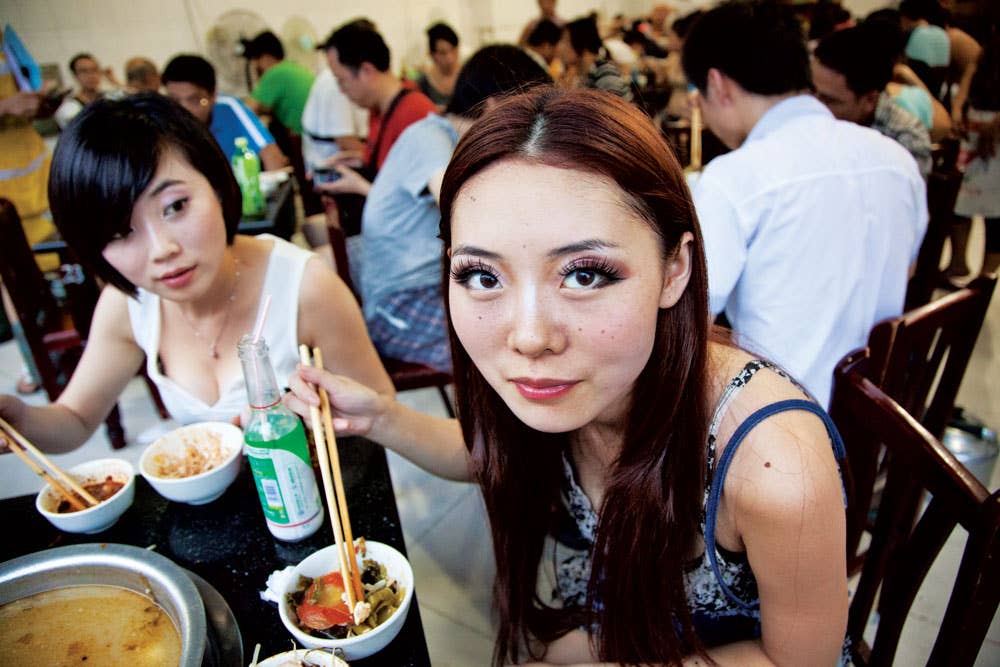
I was walking down a narrow street in the suburbs of Chengdu, the capital of China's Sichuan province, when I spotted what I'd been hoping to spot for days: a tricycle. No ordinary conveyance, this; it was a mobile food vendor of the sort that specialized in dou hua, super-soft tofu drenched in black vinegar and chile-infused oil, topped with scallions, peanuts, pickled turnips, and fried shallots. The vendor ladled tofu from a basin in the back of the trike into a little plastic bowl, seasoned it, and handed it to me. With a thin plastic spoon, I scooped up a bite and put it in my mouth. Heaven. The tofu was warm and silky, with a hint of smoke, against which the garnishes were a rainbow of salty, sour, pungent contrast. Far too soon, my bowl was empty.
It was then that I noticed my tongue was on fire, burning with the heat of a thousand chiles, a spiciness known in Mandarin as la. I felt droplets of sweat form on my cheeks. The spice swelled and pulsed. Behind the la was a citric flavor and a numbing sensation that tingled the sides of my tongue; it at once protected me from the power of the chiles and, somehow, increased my sensitivity to it. This was ma, the effect produced by Sichuan peppercorns, called hua jiao in Mandarin—little dusky pink fireballs that are actually the dried seed husks of the prickly ash tree.
Those two flavors—ma and la, Sichuan's signature combination—were precisely what I'd come to Chengdu looking for. See, I'm a chile fiend. My pantry features an entire section devoted to dried peppers from Thailand, China, Mexico, India, Kenya, and Israel, and my refrigerator shelves sag with unlabeled bottles of homemade hot sauces. I'm neither macho nor masochistic, and while I could lecture you on Scoville units, capsaicin, and endorphins, I'll keep it simple: I think heat makes food taste better.
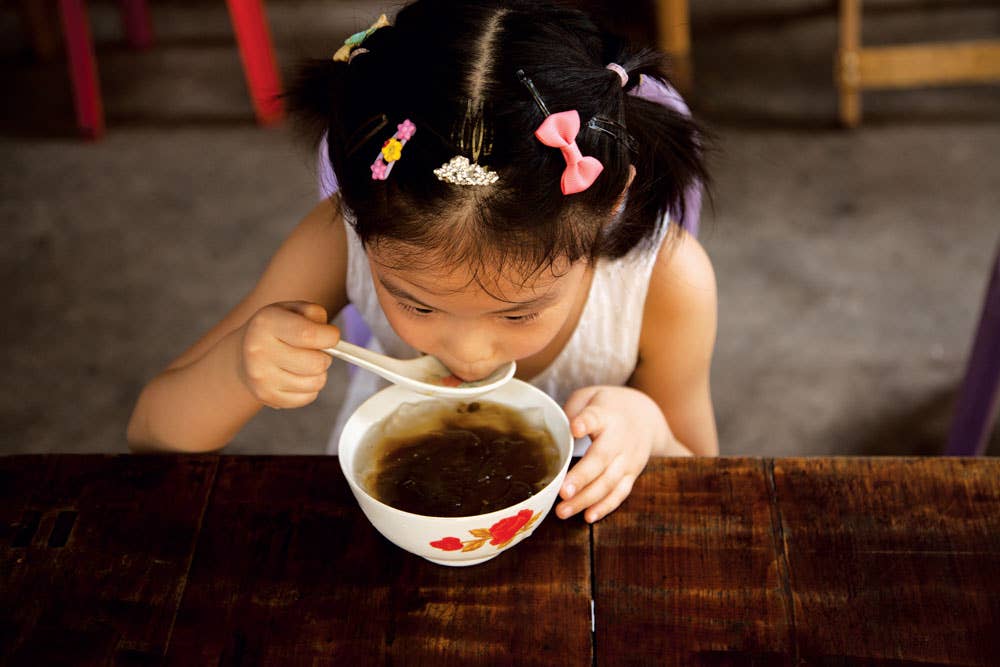
In this regard, the food of Sichuan has always held a talismanic appeal for me, ever since my first taste of truly authentic Sichuan cooking at a restaurant in Taipei a decade ago. No other cuisine, to my mind, makes such liberal use of chiles while at the same time achieving such complexity and balance. For years I sought out Sichuan food wherever I could find it—in New York, in Los Angeles, and beyond, chasing that chile-fied buzz. Finally, I resolved to visit the heat at its source. But while I'd come in pursuit of ma la, once here, I found that this famous spiciness is but one piece of a multifaceted cuisine. Among the Chinese, this southwestern province is considered the home of the country's most sophisticated food, a place where cooks are known to unite strikingly disparate flavors (see Flavors of Sichuan) in a single harmonious dish. Today the nexus of this cuisine is Chengdu.
The city of 14 million inhabitants lies on a vast fertile plain some 50 miles east of the Tibetan plateau foothills. Chengdu sits virtually in the center of the province, a circumstance that aided the city's rise; it was in Chengdu's teahouses that silk traders and traveling officials lingered on their journeys, lending the city a sensual, cosmopolitan air. Nowadays that legacy expresses itself in a vibrant, even frenetic, food culture, which recently earned Chengdu a UNESCO "City of Gastronomy" designation, the first in Asia.
Chengdu has its share of overdevelopment, with skyscrapers replacing quaint downtown neighborhoods and cookie-cutter housing developments sprawling into the distance, but even so, the city possesses a laid-back vibe that stands in contrast to the world-ruling auras of Beijing, Shanghai, Shenzhen, and Hong Kong. As soon as I arrived, I checked into a hostel near the city center, and proceeded to eat my way across town.
In the early morning hours of my first full day in the city, when the streets around the hostel were serene, I went for a run, skirting the edge of People's Square, Chengdu's geographical center, until I reached the banks of the mist-shrouded Jinjiang River, one of four waterways that interlace the city. As I crossed bridges, I dodged grandmothers returning from crack-of-dawn market excursions, lugging jugs of rapeseed oil, used for frying, and shopping bags overflowing with greens. On my way back, I bought pork buns from a little shop called Hanbaozi. Through its wide take-out window, I could see cooks stuffing soft white wheat-flour buns with ground pork seasoned liberally with Sichuan peppercorns. With every bun I ate, that tingly numbness—the ma—crept farther across my tongue and palate. An order of four buns, plus a glass of warm soy milk, made a very good breakfast.
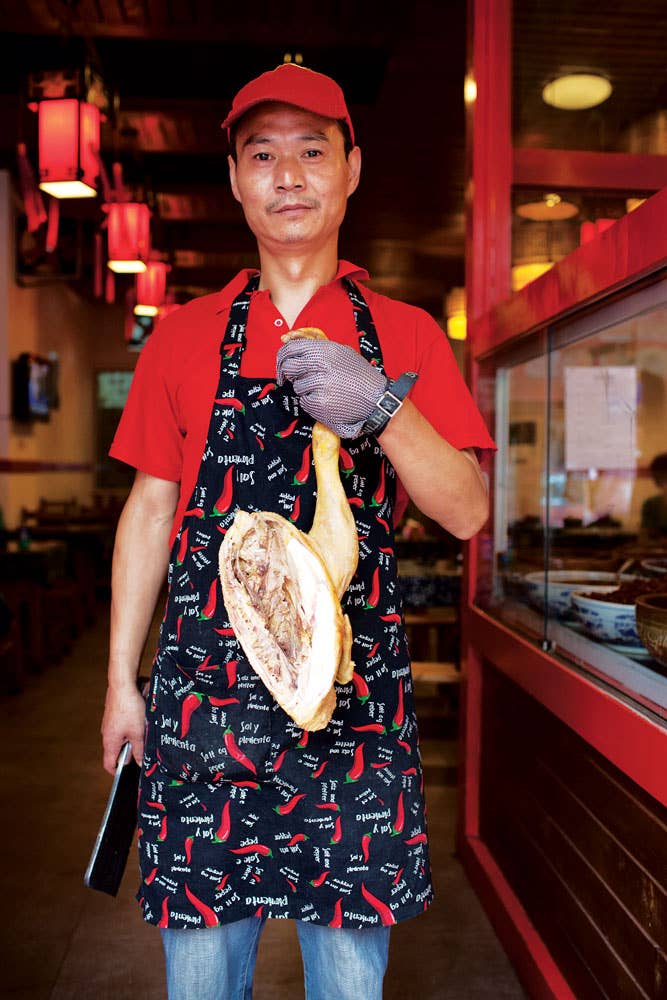
Or a good first breakfast. After I showered, I wandered over to Chunyangguan, one of the city's myriad noodle shops, where dozens of wooden tables and chairs were set out in front of a low concrete building. By nine o'clock, nearly all were filled with customers. I sat down, and the laoban, or boss, came over to take my order. With my limited Mandarin, I asked for what everyone else seemed to be having: yu xiang pai gu mian, or fish-fragrant sparerib noodles. In moments I was slurping down a bowl of thin white wheat noodles nestled in a dark broth tinged red with chile oil and studded with nuggets of spareribs. A dash of black vinegar added a note of sharpness.
Fish-fragrant sparerib noodles, it is important to know, do not smell or taste like fish. Rather, "fish-fragrant," as I learned from the laoban, a no-nonsense middle-aged former salesman who introduced himself as Ma Yingjun—Handsome Ma—refers to the ingredients typically used in cooking fish here: garlic, ginger, scallions, and, often, pickled chiles. Fish-fragrant dishes are frequently stir-fried, but Handsome Ma's yu xiang pai gu mian was more complicated, beginning with a stir-fry and segueing into a long braise. The aromatic dish, an invention of Handsome Ma's, blew me away. I slurped through the bowl in seconds. Then I looked around at the neighboring tables to see what else to try.
The next thing I spotted was a small bowl filled with steamed egg custard, topped with a spoonful of ground pork and chopped ya cai (pickled mustard greens). The egg itself was preternaturally light and creamy, and when I asked Handsome Ma how it was done, I couldn't believe the simplicity of the preparation: just eggs, beaten and steamed. They offset the noodles perfectly.
This combination was my first taste of how meals worked in Chengdu. For every complicated, labor-intensive dish, such as the fish-fragrant noodles or Handsome Ma's excellent hong you chao shou (spicy pork wontons in red chile oil), there was an accompaniment that involved just two or three ingredients of mellow yet transcendent flavor. This balancing act took place in meal after meal. Later that afternoon in a suburb of Chengdu, I ventured a taste of ma la rabbit heads, a surprisingly delectable treat that was possibly the spiciest and most complexly flavored thing I'd ever eaten, and it, too, was paired with a simple porridge of rice and purple sweet potatoes—wonderful.
I spent the next day exploring Chengdu's many neighborhood markets, studying the local chiles. The varieties were mind-boggling: I found xiao mi la, a sharp-tasting hot pepper reminiscent of a Thai bird's-eye chile that infuses braises with vivid heat; chao tian jiao, or "heaven facing chiles," used sun-dried, wok-toasted, and then coarsely ground; erjingtiao, deep green or red peppers that are pickled and minced for a mildly spicy seasoning; ye shan jiao, chiles ranging from purple to green in color that grow wild in the mountains; and more.
Given the abundance of chiles here, I found it hard to believe that people in Sichuan only really started cooking with them in the 19th century, 300 or so years after they were first imported from the New World. The fact is, chiles were just one felicitous addition to an ancient cuisine that has always placed great value on bold flavors. Before chiles arrived, cooks often paired Sichuan peppercorns with the sour red fruit of the Japanese Cornelian cherry tree. Chiles, when they finally came along, must have felt something like the missing piece of a very old puzzle.
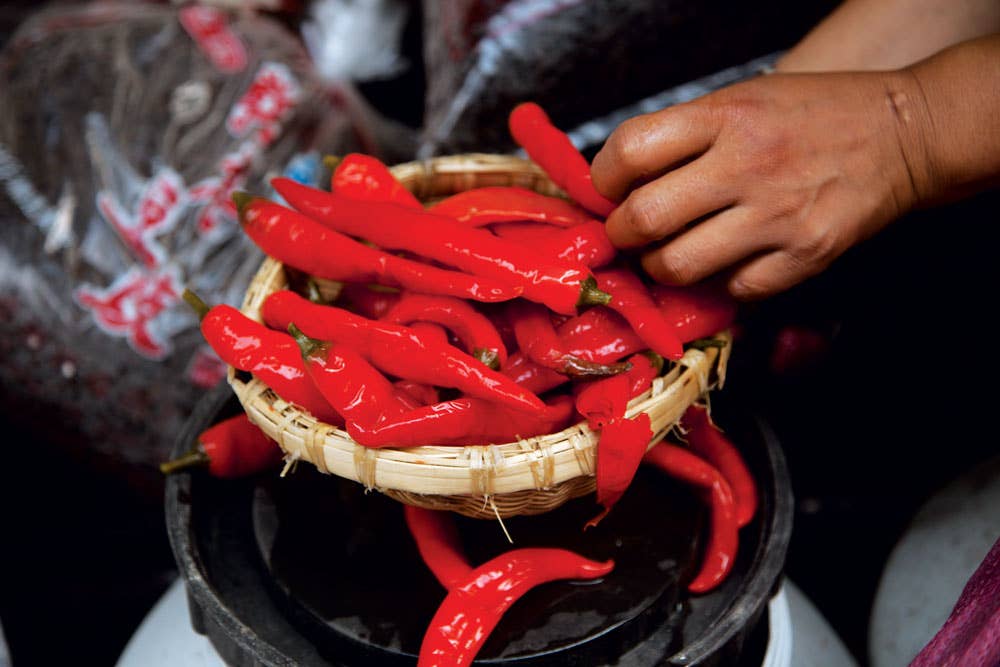
Chiles are also a key ingredient in another bedrock element of Sichuan cooking, douban jiang, a powerful dark red fermented paste of erjingtiao chiles and broad beans that is responsible for the deep umami flavor and penetrating heat in dishes such as Sichuan's famous mapo tofu and ground beef or pork braised in a fiery ruby red sauce. Chile bean pastes of various types are produced all over China, but the best, I was told, come from Pixian County, just outside of Chengdu.
To learn more about the chile paste, I paid a visit to Pixian County's Museum of Sichuan Cuisine, where I beheld, sitting outside in the courtyard, row upon row of open-topped clay pots containing fermenting chiles and beans on their way to becoming douban jiang. A manager of the museum's classical collections, Ding Shibing, explained why Pixian is ideally suited for producing the ingredient. In other parts of the country, chile bean paste makers regularly have to add water to their fermenting product to replace moisture lost to evaporation. Not in Pixian, where the ancient irrigation system that turned Sichuan basin into an exceptionally fertile area—a marvel of hydraulic engineering completed in 256 B.C. and still in use—helps to maintain sufficient ground humidity to keep the paste from drying out as it ages. Dujiangyan, as the vast network of canals is named, not only ensures the country's best douban jiang, but earned Sichuan the enduring moniker, the Land of Plenty.
Chengdu people take that to heart. They make the most of their bounty and the remarkable local larder it yields—not just chiles and those peppercorns but a cornucopia of fruits, cultivated and wild vegetables, and more. They are as obsessed with food as you'd imagine for a people whose native poets immortalized the cuisine (11th-century bard Su Dongpo on fatty pork: "Simmer slowly/With a little water"). These poets have contemporary counterparts in characters like "Super Piggy," one of Chengdu's many food bloggers.
"I am a Sichuanese man. If I am not eating something, I must be thinking about what to eat," said Super Piggy, whose real name is Xu Yun, when I met him for lunch one day. We were eating offal, beloved in Sichuan, at Ming Ting, one of Chengdu's "fly restaurants," bare-bones eateries said to attract diners like flies. Over lunch—pigs' brains braised with tofu and douban jiang; pigs' kidneys stir-fried with a mountain of chives—Yun, a trim man in his mid-30s, waxed philosophical, quoting Plato as easily as Chinese poets. As our conversation turned to the cooking of Chengdu, he said that if I really wanted to experience the city's cuisine, I'd best get into the kitchens of its home cooks.
The next day, I visited Yun's father, Xu Shengguo, a retired engineer who'd cooked for his family for decades. With practiced efficiency, Shengguo whipped up hui guo rou, pork belly stir-fried with chile paste, dou chi (salty, black fermented soybeans), and garlic scallions. As the ingredients sizzled, the chile smoke rising from the pan nearly made me sneeze. Shengguo also produced yu xiang you cai, using the fish-fragrant technique on rape greens. He finished by making ma yi shang shu, literally, "ants climbing a tree," a homely dish of glass noodles stir-fried with ground pork. We sat and dug in, and between the crisp and spicy pork belly, the tender and slightly bitter you cai, and the slippery glass noodles, the meal was as complex and balanced as anything I'd eaten out in the city. But it was also casual, just Papa Piggy preparing dishes he knew intimately and riffing on classics. At home, it seemed, Sichuan cuisine was a style, an approach that encouraged innovation, not a rigid canon. I was bowled over.
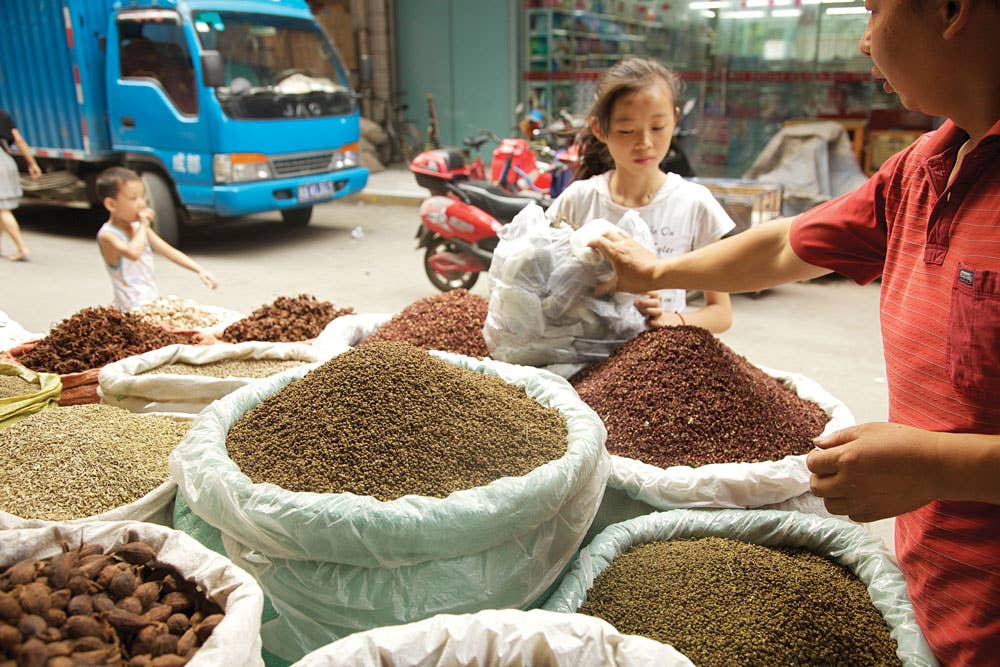
I spent the rest of my stay seeking out invitations to eat in people's homes, where I encountered this deliciously freewheeling approach to cooking, grounded in the basic flavors of Sichuan but relaxed and improvisational, again and again. One evening Guo Wei-Wei, a young dimple-cheeked writer, had me over to dinner at her brand-new apartment, where she broke down a five-pound rooster, fried some of the meat with shredded young ginger and chiles, and stewed the rest of it with carrots and douban jiang, yielding one chicken two ways—both of them delicious.
On my last night in Chengdu, I went to a dinner party hosted by Ivy Hui, an avid home cook. When I arrived, Hui was preparing sweet and sour fried meatballs made from not just pork but, of all things in landlocked Chengdu, oysters, which lent an ingenious note of brine. Hui also served spareribs that had been braised in lu—a mix of spices such as cassia, star anise, and fennel seed—and then deep-fried and tossed in a hot wok with generous handfuls of xiao mi la chiles. The ribs had a complex flavor that combined the must of a spice market, the fatty punch of barbecue, and a penetrating heat—a masterfully Sichuanese balance of power.
As I devoured the spareribs I could feel the familiar heat—the ma and la that had brought me here—rising in my face. With my chopsticks I plucked a slice of raw cucumber from a plate and crunched it in my mouth. A counterpoint to the frenzy of flavors that surrounded it, the cool vegetable quieted my palate just long enough before the chiles beckoned once again.
Keep Reading
Continue to Next Story










